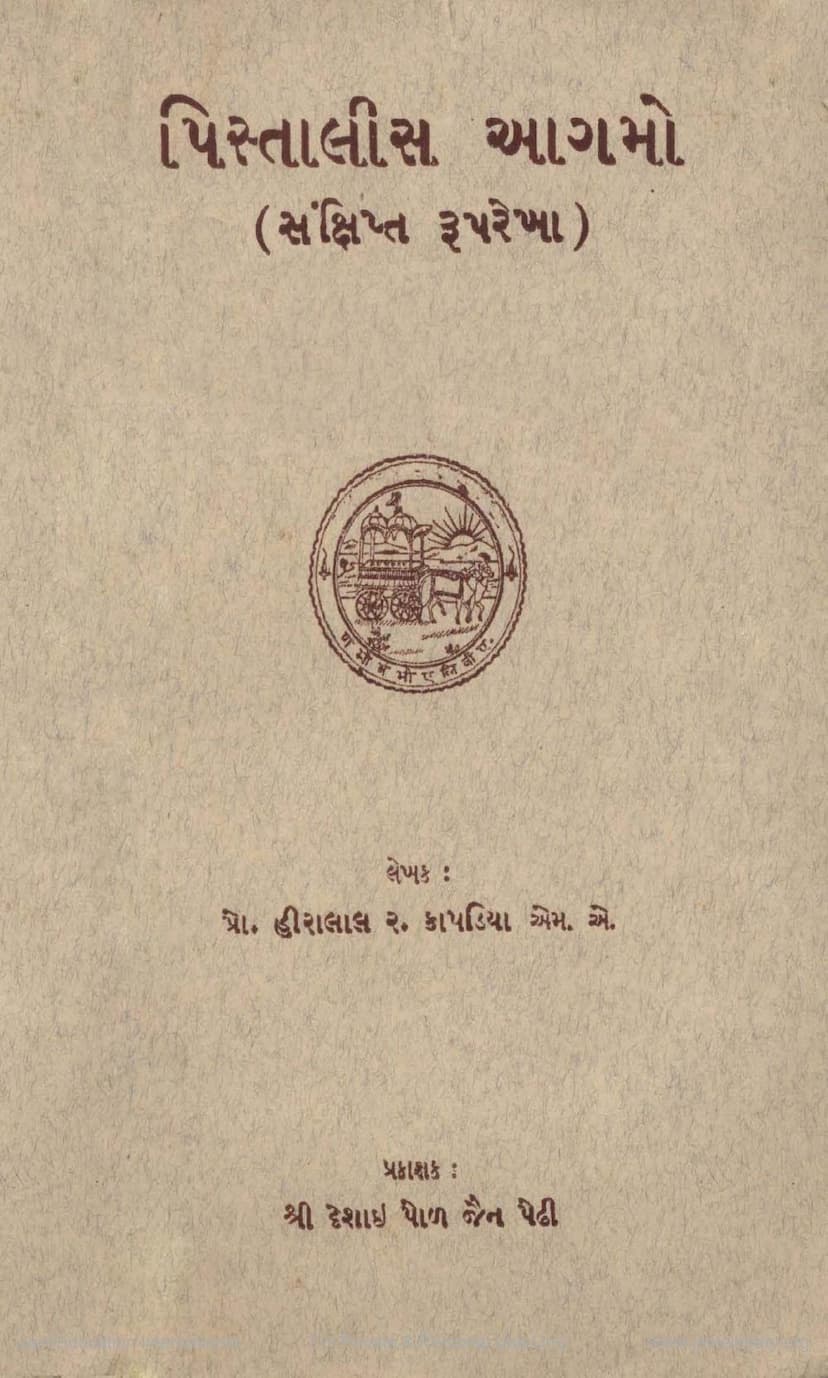Pistalisa Agam Sankshipta Ruprekha
Added to library: September 2, 2025

Summary
This document is a comprehensive outline of the "Forty-Five Agamas" (Pistalisa Agam) of Jainism, authored by Prof. Hiralal R. Kapadia. It serves as a guide to the structure and content of these sacred Jain scriptures.
Here's a breakdown of the key information presented:
Book Details:
- Title: Pistalisa Agam Sankshipta Ruprekha (A Brief Outline of the Forty-Five Agamas)
- Author: Prof. Hiralal R. Kapadia, M.A.
- Publisher: Sha Hirabhai Naginbhai Jariwala (also mentioning Shri Desai Pal Jain Pedhi)
- First Edition: V.S. 2010 / Vira Samvat 2480 / A.D. 1954
- Price: Rs. 9-8-0
- Catalog Link: https://jainqq.org/explore/004616/1
- Dedication: The book is dedicated to Acharya Shri Vijay Vignansurishwarji Maharaj Saheb.
Core Concept: The Agama Purusha (Image of the Agama)
The book introduces the concept of the "Agama Purusha," a metaphorical representation of the Jain Agamas as a human body. This concept, first hinted at by Jinadāsagaṇi Mahattara in his commentary on the Nandi Sutra, visually organizes the vast body of Jain scriptures.
- Body Parts and Agamas: The twelve Angas (primary scriptures) are mapped to different body parts, starting with the feet and moving upwards to the head.
- The two feet represent the first two Angas.
- The two shins represent the next two Angas.
- The two thighs represent the next two Angas.
- The two arms represent the next two Angas.
- The neck represents the penultimate Anga.
- The head represents the final Anga.
- Chulikas: The two Chulika Sutras are depicted as framing the head (Bhamandal).
- Root Sutras: The four Mul Sutras are presented as the roots of the lotus stalk that supports the Agama Purusha.
- Prakirnakas: The ten Prakirnakas are depicted as the rays emanating from the sun, symbolizing their diverse and supplementary nature.
- The Forty-Five Agamas: The total count is derived from:
- 11 Angas (the 12th Anga, Drishtivad, is lost)
- 12 Upangas
- 4 Mul Sutras
- 6 Ched Sutras
- 10 Prakirnakas
- 2 Chulika Sutras
- (The text also mentions 6 Ched Sutras and 10 Prakirnakas, and then lists them, totaling 45. There's a slight discrepancy in initial counts vs. detailed listings which is common in such textual compilations).
- Posture: The Agama Purusha's standing posture resembles the Karyotsarga mudra (standing in detached meditation), with the palms in Abhaya Mudra (fearlessness), signifying the offering of protection to those who truly worship the Agamas.
Structure of the Book:
The book systematically categorizes and describes the Agamas into six main sections:
- Chapter 1: Pithika (Introduction): Discusses the origin of the Agamas, the concept of the "Agama Purusha," and the classification of the Agamas. It also explains the different types of commentaries (Niryukti, Bhashya, Churni, Tikka).
- Chapter 2: Eleven Angas: Details the eleven extant Angas, including their names, structure (skandhas, adhyayanas, sutras), key topics, authors (where known), and approximate size in verses. The Angas covered are:
- Acharanga (Ayar)
- Sutrakritanga (Suyagada)
- Sthananga (Thana)
- Samavaya (Samavaya)
- Vyakhyaprajnapti (Vivahapanutti / Bhagavati Sutra)
- Jnatadharmakatha (Nayadhammakaha)
- Upasakadasha (Uvasagadasa)
- Antakriddasha (Antagadadasa)
- Anuttaraupa-patikadasha (Anuttaravavaiyadasa)
- Prashnavyakarana (Panaavagaram)
- Vipaka-shruta (Vipagasuya)
- Chapter 3: Twelve Upangas: Describes the twelve Upangas, which are considered supplementary to the Angas. These include:
- Upapata (Evavaiya)
- Rajaprasniya (Rayapaseniya)
- Jivabhigama (Jivabhigama)
- Prajnāpanā (Panhavanana)
- Suryaprajnapti (Surpanatti)
- Jambudvipa-prajnapti (Jambudviyapannatti)
- Chandraprajnapti (Chandapanatti)
- Nirayavaliya (Nirayavaliya)
- Kalpa-pratiksepika (Kapadisaya)
- Pushpa (Pushfiya)
- Pushpachulika (Pushpachulia)
- Vrishni-dasha (Vunhidsa)
- Chapter 4: Mul Sutras: Explains the four Mul Sutras, considered foundational texts for ethical conduct and practices. These are:
- Avashyaka (Avasaya)
- Uttaradhyayana (Uttarajjhayana)
- Dashavaikalika (Dasaveyaliya)
- The fourth Mul Sutra is debated, with some suggesting Eghaniryukti or Pindavirukti.
- Chapter 5: Six Ched Sutras: Details the six Ched Sutras, which deal with penance and expiation for transgressions in conduct. These are:
- Nishithi (Nisih)
- Dasha (Dasa)
- Kapa (Kapp)
- Vyavahara (Vavahara)
- Chhata-kapa (Chhakkapp) - mentioned as unavailable, often substituted.
- Mahanishithi (Mahanisih)
- Chapter 6: Ten Prakirnakas: Describes the ten Prakirnakas, which are miscellaneous scriptures covering various topics. These include:
- Devendra Stava (Devindathay)
- Tandula Vaicharika (Tandulaveyaliya)
- Ganividya (Ganivijja)
- Atura Pratya-khyana (Aura-pachchhakhan)
- Maha Pratya-khyana (Mahapachchhakhan)
- Gachchhadhara (Gacchhachar)
- Bhaktaparigya (Bhattaparina)
- Marana Samadhi (Maranasamahidi)
- Samstara (Samthara)
- Chatuhsharana (Chausarana)
- Chapter 7: Two Chulika Sutras: Covers the two Chulika Sutras, which are considered supplementary to the Angas and provide further clarification. These are:
- Nandi (Nandi)
- Anuyogadvara (Anuyogadvāra)
Key Features and Contributions:
- Systematic Classification: The book provides a clear and organized overview of the complex Jain canon.
- Content Summaries: Each Agama and its sections are briefly described, highlighting their main themes and subjects.
- Authoritative Information: It draws upon existing commentaries and traditions to provide details about the Agamas.
- Scholarly Approach: The author acknowledges different opinions and scholarly debates regarding the precise details of some Agamas.
- Historical Context: It offers insights into the estimated time of compilation and authorship of various Agamas.
- Literary Analysis: The book touches upon the language, style, and poetic aspects of the Agamas.
- Pioneering Work: The book aims to fill a gap by providing a concise yet comprehensive overview for both Jain and non-Jain readers, bridging the gap between extremely brief enumerations and lengthy commentaries.
Overall Purpose:
"Pistalisa Agam Sankshipta Ruprekha" is a valuable resource for anyone seeking to understand the vast and intricate world of Jain scriptures. It offers a structured approach to learning about the Agamas, making this profound knowledge accessible to a wider audience. The detailed descriptions and the introduction of the "Agama Purusha" metaphor contribute significantly to the appreciation and study of Jain philosophy and literature.